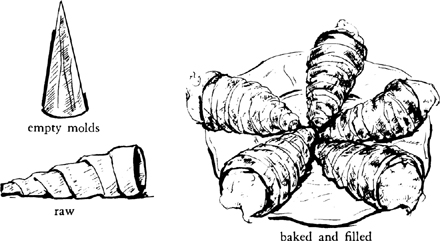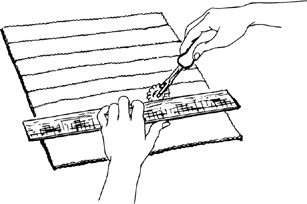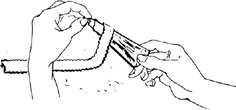Mastering the Art of French Cooking, Volume 2 (63 page)
Read Mastering the Art of French Cooking, Volume 2 Online
Authors: Julia Child

If you are very skillful, you can manage to make a few careful rolls with your pastry pin and join the seams of dough so perfectly that you can cut it out for patty shells or the 2 large disks needed for a
Pithiviers
. The surest system, however, is to
flour dough lightly, roll into a rectangle, spread the top two thirds with a tablespoon of softened butter and fold in three. Wrap, chill an hour or two, and finish off with 2 more turns. Refrigerate for several hours or overnight, or freeze, so that dough will relax thoroughly before you use it again.
Re-use of leftovers
You can still get puffing and flakiness out of the leftover of leftovers, using the preceding system. The pastry will not be as tender when baked as it was at first, and it may well offer a bit of resistance when you roll it out. However, it works very well for most appetizers, as well as for cookies and for the
fleurons
and the
petites bouchées
in the 2 preceding recipes.
Puff Pastry Entrées
Cornets, Rouleaux, Cheese Napoleons, and Cheese Tarts
Just a few of the many delicious pastries you can make with
pâte feuilletée
are described and illustrated in the following pages; see also
dessert pastries
and
cookies
. One could easily write a book on puff pastry alone, and we find it hard to limit ourselves to a sensible few. We hope, however, that these recipes will give you a feel for how to use it so that you can go off on your own and be confident with other recipes you find elsewhere.
CORNETS
[Puff Pastry
Horns—Cream Horns]
Strips of puff pastry are rolled around cone-shaped forms, baked until the pastry has browned and set, and baked again with a creamy cheese filling to make a most attractive first-course fantasy. (Encrusted with sugar, they
come out of the oven with a caramel
coating for dessert creams
.)
For 18 to 20 horns about 5 inches long, serving 8 to 10 people
1)
Forming the dough
18 to 20 buttered cream-horn molds (or bake the pastry in several batches)
2 large pastry sheets rinsed in cold water but not dried
½ the recipe for
chilled simple puff pastry
A tray lined with wax paper for refrigerating pieces of dough you are not actually working on
A ruler or cutting guide
A ravioli wheel
A pastry brush and cup of cold water
Stand the buttered molds within easy reach, and have the pastry sheets near you. Roll the chilled pastry out into a rectangle 14 inches long, cut in half crosswise, and refrigerate 1 piece of dough. Roll remaining piece of dough rapidly into a rectangle ⅛ inch thick and slightly more than 8 by 13 or 14 inches in diameter. Trim off ragged edges. (If kitchen is hot, work very rapidly, and refrigerate all pieces or strips of dough you are not actually working on in the following steps.)
| Cut strips of pastry ¾ to 1 inch wide and 13 to 14 inches long, using cutting guide and pastry wheel as shown |
| Paint a half-inch band of cold water along top length of a strip of dough. |
| Holding tip of mold with your left hand, with your right hand rotate its large end clockwise—to your right—winding the dough onto the mold in a spiral from tip to large end |






